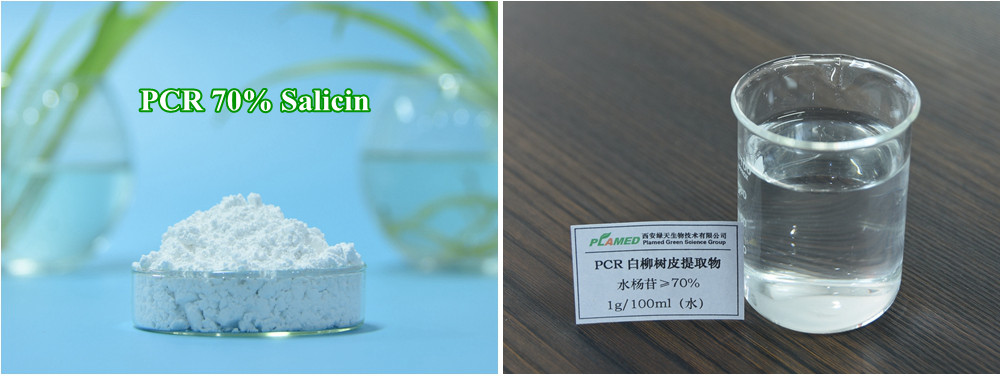1. Salicin & Salicylic Acid Development
As early as 1534 BC, the ancient Egyptians began to use the bark of willow trees to relieve inflammation and pain. Hippocrates, the founder of Western medicine, used willow leaf sencha for pregnant women to relieve labor pains during childbirth. In China, Li Shizhen, known as the “Sage of Medicine”, also mentioned willow bark’s pain relieving effect in “Compendium of Materia Medica”.
In 1828, French pharmacist Henri Leroux and Italian chemist Raffaele Piria succeeded in separating and purifying the active ingredient salicin from willow bark. So, salicin, as an anti-inflammatory ingredient, is also known as willow bark extract. It is white powder with hygroscopicity, widely found in the bark and leaves of many willow and poplar plants. As an example, the bark of purple willow contains up to 25% salicin. Meanwhile, sacilin can be converted into salicylic acid in vivo. But this two ingredients have different chemical structures. Therefore, they are different in skincare. Compared to salicylic acid, salicin has more skin benefits.

2. Sacilin VS. Salicylic Acid Benefits for Skin
2.1 Salicin Skin Benefits
Salicin ia an active ingredient extracted from the bark of white willow tree. It has the aspirin-like properties. As an oxidase inhibitor, salicin can promote skin metabolism, increase skin gloss and elasticity, and reduce pigmentation. Moreover, it can penetrate the skin in a suitable carrier, then to exert its anti-inflammatory and antibacterial effect. Salicin can facilitate to shed epidermis cells, and open clogged pores. More importantly, salicin has the effects to improve skin aging when applied topically. It can be used in medicine, health care products, cosmetics and other fields, and has broad market prospects.
Salicin is also an effective anti-bacteria agent. In addition to its ability for anti-inflammation, it’s really the perfect choice for topical use for various skin conditions. When applied to face skin, salicin is mild enough to improve skin irritation and redness to repair skin to a normal skin tone.
There are many genes in the skin that directly affect the rate and severity of skin aging. The expression of these genes changes with age, which is a major cause of skin loss of elasticity, wrinkles, fine lines, as well as sagging skin. Studies suggested that regular use of salicin can reduce the expression of genes that cause skin aging, and promote the expression of genes that make skin look more healthy and young.
2.2 Salicylic Acid Skin Benefits
Salicylic acid is a fat-soluble organic acid. On the one hand, salicylic acid molecules can penetrate into the oil-clogged parts and help unclog the pores. On the other hand, salicylic acid itself has an anti-inflammatory effect, which can relieve inflammation in the acne area. However, salicylic acid is toxic. Salicylic acid at a high concentration is not suitable for use on the skin. There is a certain concentration limit. Salicylic acid with a concentration of 3%-6% can be used to exfoliate. When exceeding 6%, it will cause skin irritation. 40% high concentration of salicylic acid has strong keratinous corrosive properties.
3. Sacilin VS. Salicylic Acid Application in Cosmetics
Therefore, in skin care, salicin and salicylic acid have different applications. Salicin is more mild, non irritating than salicylic acid. It is generally applied into anti-aging and anti-inflammatory products. Thus, salicin is a good alternative to salicylic acid. Salicylic acid is mostly present in anti-acne products, but it’s more irritating to skin.
Additionally, salicin is almost suitable for all skin types; while salicylic acid is friendly to oily skin, instead of sensitive skin and dry skin.
Mentioned above, salicin can be converted into salicylic acid in acidic medium. It is a natural component that has a significant effect on removing dead skin cells. It is suitable for acne-prone and sensitive skin. Actually, salicin’s concentration in cosmetic formula will not exceed 5%, otherwise, it will cause skin disorders.
To sum up, salicin has lots of benefits for skincare, compared to salicylic acid.
As a professional salicin Manufacturer and supplier, Plamed provides cosmetic grade ingredients 10% Salicin and 70% Salicin. Plamed salicin has good water solubility, without any precipitate. More importantly, 70% salicin is of high content with more obvious skincare benefits. What’s the differences between Plamed salicin and salicin on the market?
Plamed has established the salicin standards, including raw material origin, raw material harvest, testing standards for raw materials, such as heavy metals, pesticide residues and salicin content, etc.
We named the white willow bark extract produced by the above standard system as PCR70% Salicin. The efficacy test data, safety data and stability data we have done now and in the future are all based on PCR70% Salicin.








